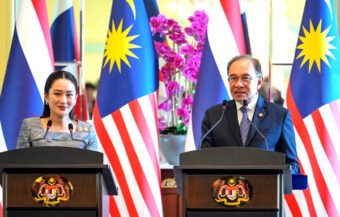Figures for trade for the first two months of 2019 show a continuation of a trend that began in 2018. Thailand’s exports are declining. One of the main factors, believed to be driving the trend, is the continuing high value of the Thai baht even though its value has not changed in the last 12 months against the US dollar, the value of the baht is still at a relatively high level. It has also risen against other local currencies and the euro. Other reasons, being given, are the US China trade war, the end of a technological cycle and a poorer world economic conditions.
Before the election, the Thai government announced record tax revenues and a significant increase in refunds. It shows the health of the economy. However, the continued decline in exports since the latter half of last year is becoming a source of concern. It is part of an overall pattern of fall offs in Thailand’s cross border trade revealed this week by the Ministry of Commerce in Bangkok. Experts have cited 4 different reasons for the slump but chief among them is the stubbornly high value of the Thai baht.

Thailand’s economic leadership is playing a cautious game as reports continue to indicate a weakening of exports from the kingdom and overall cross border trade activity.
The latest figures, just released by the Commerce Ministry in Bangkok, show overall cross border trade fell by just shy of 2.5% for February based on 2018 figures. The total trade figures for the month was ฿83.8 billion.
Thailand’s exports for February down 3.8%
The figures show exports from Thailand were nearly 3.8% lower than last year’s figure for February. Exports were recorded at ฿48.4 billion. Imports for the month of February were also down by 0.63% with a total figure of ฿35.3 billion. This left Thailand with a trade surplus of ฿13.1 billion for the month.
Strong value of Thai baht blamed for export decline
Mr Adul Chotinisakorn is the Director General of the Foreign Trade Department at the Thai Commerce Ministry. He blamed the decline in Thai exports primarily on the strong value of Thai baht. The impact of this was quite acute in recent months as the value of the Burmese kyat, the currency of Myanmar, had declined. He also pointed to increased competition in the Asean market from cheaper Chinese exports.
Exports also down for the first two months of the year
Figures for the first two month of 2019, however, show Thailand’s cross border up nearly 1% but this figure is believed to be influenced by some anomalies. The total trade value for the two months was ฿219.5. Thai exports were down nearly 2% of the period at ฿121 billion while import figures were up somewhat by nearly 4.7%. The surplus was ฿23.1 billion.
Trade with neighboring countries down
It is clear that Thailand’s export performance since the latter half of last year, has been facing challenges. In the first two months of 2019, the kingdom’s trade with its four neighbouring countries was down. Overall, trade tailed off by 1.65% to ฿179 billion made up of ฿101 billion in exports representing a reduction of 3.63% compared to last year’s figures. Imports were down by just over 1% at ฿77.5 billion. The four countries concerned were Malaysia with ฿88.7 billion in trade, Laos with ฿31.7 billion, Myanmar with ฿31.2 billion and Cambodia which came in at ฿27.3 billion.
Trade was up across Southern China, Vietnam and Singapore but it resulted in a deficit
The Trade Department highlighted a combination of trade with Singapore, Vietnam and Southern China as a bright spot in what must be said to be a bleak report. For this selected area, trade was recorded at ฿40.6 billion, up by 14.1%. Exports to this area grew by nearly 7.7% to ฿19.9 billion with a large increase in import trade recorded at 21% to ฿20.7 billion. The combined area figure showed a trade deficit for the two month period of nearly ฿716 million.
The Director emphasised that his department remains positive and pointed to a potential for increased exports to Laos where that country is rebuilding following flood damage to its southern provinces.
Bank of Thailand left interest rates unchanged this month to create right conditions for growth
Thailand’s commercial exports are in the midst of a slump with the latest figure confirming the trend for the first two months of the year. This led the Bank of Thailand’s Monetary Policy Committee, in the middle of March, to leave interest rates in Thailand unchanged at 1.75%. The bank reduced the figure for projected growth in the Thai economy this year to 3.8% and held the forecast growth rate for next year at 3.9%.
Range of reasons cited and explained for the decline in Thailand’s export growth since 2018
There are now a number of reasons being advanced for the reversal of fortune for the export sector since the middle of last year. The top reason is the US China trade war. Despite initial theorising that it would only marginally impact Thailand, this has proved incorrect. It is becoming clear that the fallout from the trade spat between the two world powers is impacting Thailand’s growth sector. There has been disruption to production networks, a slowing off in demand in China and what is becoming quite significant, increased competition from Chinese players the Asean market.
Technology cycle as firms change direction
The second reason being suggested is the end of a technology cycle across the world. This has seen weaker demand for technology hardware as the market regroups for the next big thing and newer competitors emerge from China and India.
World economy is slowing and outlook is darker
The third and perhaps the most worrying scenario and linked to the US China trade war, is the overall slowing of the world economy as a range of issues coincide. These issues range from political instability in Europe to Brexit to a Chinese slow down and the heightening of effects caused by the US President’s America First economy policy. What is worrying world leaders is the possibility of some singular event or financial shock which could signal the beginning of something even more dangerous. This nervousness is impacting Thailand in more than obvious ways. One result has been a flight of private capital from China into Thailand.
Strong Thai baht is the biggest factor in export decline
However, the most obvious issue for Thailand is the increasing value of the Thai baht which is directly now undermining Thailand’s competitiveness even at the level of agricultural produce. The cautious management of the Thai economy by the current government has seen a stable economy with all the right indicators including an unemployment rate of under 1%.
This has drawn inward investment from private investors and one has to ask whether this activity is contributing to the doggedness of the bath’s strength even as other, neighboring and competitor countries or economies see a decline in their currencies. Those countries are therefore becoming more competitive against Thailand in what is a free and open world and Asian market.
Thai baht has remained relatively unchanged against the dollar in the last 12 month but gained 10% on the euro and is 10% ahead of 2017 values.
It should be noted that the value of the Thai baht to the US dollar has remained nearly unchanged in the last 12 months. It is, however, 10% higher that the 2017 value and the baht has gained 10% in the same period against the euro. The problem for Thailand’s export competitiveness is that other countries in the region have seen lower currency values making them more competitive.
It must also be borne in mind that many large exporters hedge their bets on currency movements and this can lead to a lagging effect.
Economic growth rate set for 2019 at 3.8%
The bank and economic experts still see Thailand’s economy growing this year, driven by domestic demand. The target of 3.8% growth will now be challenging. There is some evidence that consumers in Thailand are tightening their belts in the domestic economy also as we enter into 2019. An earlier report from Honda Motorbikes which has already recorded lower sales in January and February this year, illustrates this. It saw a large drop in expensive sports motorbikes with the lower end of the market holding up. It predicts an overall decline for the year. The issue of household debt is always a factor as the working Thai public adapt to market conditions. The Thai government needs growth and stronger wage earnings to emerge, over the medium or long term, to combat this bug bear.
The Bank of Thailand has consistently underlined its commitment to creating the policy conditions to allow for increased growth. It has referenced increased level of private investment in Thailand and a continued program of public investment and infrastructure projects as positive indicators for the year ahead.


















